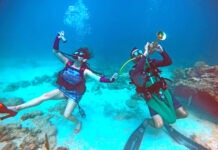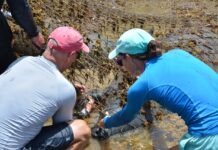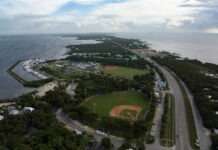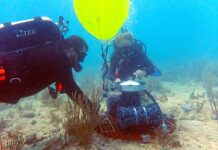In arguably the most highly anticipated opening in recent memory, officials from Monroe County, the City of Marathon, the Florida Department of Transportation (FDOT) and other community partners gathered together with the Pigeon Key Foundation and Friends of Old Seven to cut the ribbon and officially welcome the public back to the renovated Old Seven Mile Bridge. The reopening of the bridge, closed since July 2016, marks the early completion of a massive renovation project. The 30-year restoration and maintenance program was budgeted at $77 million, $41 million of which was spent to complete initial repairs.
Restoration work for the bridge that was once called the “eighth wonder of the world” included three coats of paint for a rust barrier, primer and top coat, replacement of thousands of rusted metal plates and rivets, and installation of a new aluminum rail system. To ensure structural integrity, hydraulic jacks were used to lift 10-foot sections of the bridge, cut out the original 1936 I-beams, and install brand new beams manufactured on site.
“I am absolutely elated,” said Bernard Spinrad, board president of Friends of Old Seven, the organization that united to lead the charge and save the old bridge. Thanking the county, the City of Marathon, and the DOT, Spinrad celebrated the “successful public-private partnership, the fruits of which we witness today.”







BY THE NUMBERS:
To help Keys Weekly better understand the enormous scope of Old Seven’s renovation, FDOT kindly provided these approximate numbers regarding material costs and labor statistics. Here’s what we learned:
2,017: Number of days the bridge was closed between July 5, 2016 and its Jan. 12, 2022 reopening
15,000: Gallons of polyurethane epoxy and color used to paint the outside of the bridge. The restored bridge’s official color is Federal Standard 15187, also referred to as “Federal Blue.”
2,586,190: Pounds of steel used in the replacement of I-beams and panels during the renovation.
700,000: A rough tally of the man-hours devoted to the project. If one worker labored 24/7, the project would have taken 79.9 years.
20,960: Linear feet of aluminum railing used to line both sides of the bridge.
$43,015,550: Final cost of the initial construction phase of the project.
$7,292: The amount budgeted per linear foot of bridge for repairs and maintenance throughout the project’s duration.
80: Approximate number of employees working on the bridge on any given day.
1,100: The number of ten-foot sections of the bridge raised to replace I-beams and other compromised support structures underneath.
36,000: The weight of each raised section in pounds.














